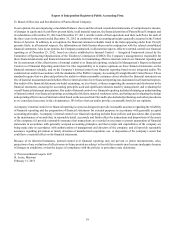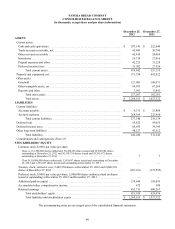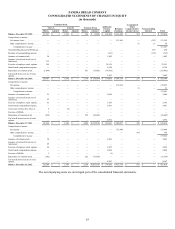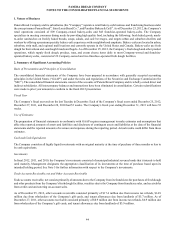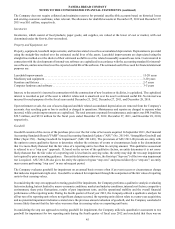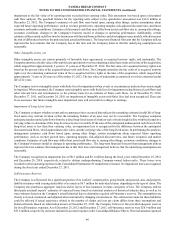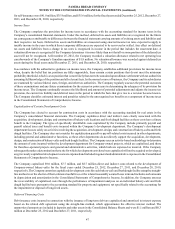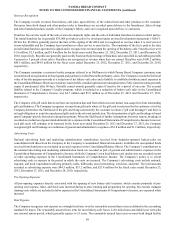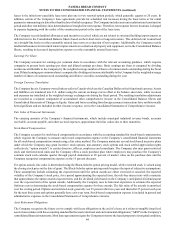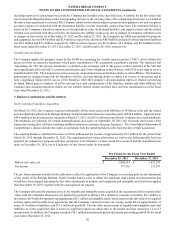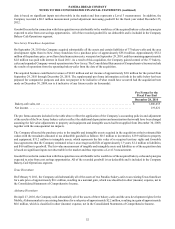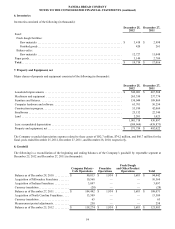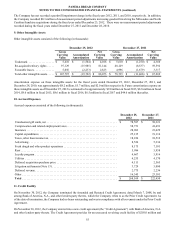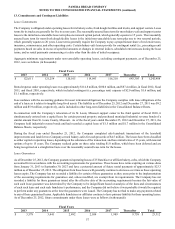Panera Bread 2012 Annual Report Download - page 57
Download and view the complete annual report
Please find page 57 of the 2012 Panera Bread annual report below. You can navigate through the pages in the report by either clicking on the pages listed below, or by using the keyword search tool below to find specific information within the annual report.PANERA BREAD COMPANY
NOTES TO THE CONSOLIDATED FINANCIAL STATEMENTS (continued)
49
leases is the initial non-cancelable lease term plus one to two renewal option periods, which generally equates to 20 years. In
addition, certain of the Company’s lease agreements provide for scheduled rent increases during the lease terms or for rental
payments commencing at a date other than the date of initial occupancy. The Company includes any rent escalations and construction
period and other rent holidays in its determination of straight-line rent expense. Therefore, rent expense for new locations is charged
to expense beginning with the earlier of the construction period or the start of the lease term.
The Company records landlord allowances and incentives received which are not related to structural building improvements as
deferred rent in the Consolidated Balance Sheets based on their short-term or long-term nature. This deferred rent is amortized
on a straight-line basis over the reasonably assured lease term as a reduction of rent expense. Additionally, the Company records
landlord allowances for structural tenant improvements as a reduction of property and equipment, net in the Consolidated Balance
Sheets, resulting in decreased depreciation expense over the reasonably assured lease term.
Earnings Per Share
The Company accounts for earnings per common share in accordance with the relevant accounting guidance, which requires
companies to present basic earnings per share and diluted earnings per share. Basic earnings per share is computed by dividing
net income attributable to the Company by the weighted-average number of shares of common stock outstanding during the fiscal
year. Diluted earnings per common share is computed by dividing net income attributable to the Company by the weighted-average
number of shares of common stock outstanding and dilutive securities outstanding during the year.
Foreign Currency Translation
The Company has six Company-owned bakery-cafes in Canada which use the Canadian Dollar as their functional currency. Assets
and liabilities are translated into U.S. dollars using the current exchange rate in effect at the balance sheet date, while revenues
and expenses are translated at the weighted-average exchange rate during the fiscal period. The resulting translation adjustments
are recorded as a separate component of accumulated other comprehensive income in the Consolidated Balance Sheets and
Consolidated Statements of Changes in Equity. Gains and losses resulting from foreign currency transactions have not historically
been significant and are included in other (income) expense, net in the Consolidated Statements of Comprehensive Income.
Fair Value of Financial Instruments
The carrying amounts of the Company’s financial instruments, which include municipal industrial revenue bonds, accounts
receivable, accounts payable, and other accrued expenses, approximate their fair values due to their maturities.
Stock-Based Compensation
The Company accounts for stock-based compensation in accordance with the accounting standard for stock-based compensation,
which requires the Company to measure and record compensation expense in the Company’s consolidated financial statements
for all stock-based compensation awards using a fair value method. The Company maintains several stock-based incentive plans
under which the Company may grant incentive stock options, non-statutory stock options and stock settled appreciation rights
(collectively, “option awards”) to certain directors, officers, employees and consultants. The Company also may grant restricted
stock and restricted stock units and the Company offers a stock purchase plan where employees may purchase the Company’s
common stock each calendar quarter through payroll deductions at 85 percent of market value on the purchase date and the
Company recognizes compensation expense on the 15 percent discount.
For option awards, fair value is determined using the Black-Scholes option pricing model, while restricted stock is valued using
the closing stock price on the date of grant. The Black-Scholes option pricing model requires the input of subjective assumptions.
These assumptions include estimating the expected term until the option awards are either exercised or canceled, the expected
volatility of the Company’s stock price, for a period approximating the expected term, the risk-free interest rate with a maturity
that approximates the option awards expected term, and the dividend yield based on the Company’s anticipated dividend payout
over the expected term of the option awards. Additionally, the Company uses its historical experience to estimate the expected
forfeiture rate in determining the stock-based compensation expense for these awards. The fair value of the awards is amortized
over the vesting period. Options and restricted stock generally vest 25 percent after two years and thereafter 25 percent each year
for the next three years and options generally have a six-year term. Stock-based compensation expense is included in general and
administrative expenses in the Consolidated Statements of Comprehensive Income.
Asset Retirement Obligations
The Company recognizes the future cost to comply with lease obligations at the end of a lease as it relates to tangible long-lived
assets in accordance with the accounting standard for the asset retirement and environmental obligations ("ARO") in the Company’s
consolidated financial statements. Most lease agreements require the Company to restore the leased property to its original condition,


